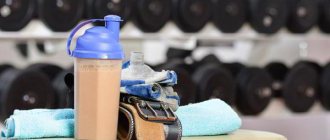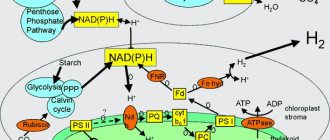What are sports drinks and who are they for?
Sports drinks are a mixture of water and salt (such as sodium and potassium) with a small amount of carbohydrates (sugar). They are designed to restore fluids and salts lost during exercise.
Sports drinks are for those who sweat. The reasons may be different: you are dancing, running, doing strength training, fencing or just walking in the heat. As soon as the body temperature rises, the body sweats and thus gets rid of excess heat, losing not only water, but also salts (electrolytes) through sweat.
Yes, your body can handle a little fluid loss, but heavy, prolonged sweating can lead to dehydration, which can impair performance and responsiveness, increase your heart rate, and make your temperature less tolerable.
Hyponatremia is a condition of the body when the concentration of sodium in the blood falls below 135 mmol/l (the norm is 150 mmol/l). Symptoms of hyponatremia: confusion, fainting, dizziness. Large losses of sodium can lead to seizures, coma, and even death.
In a 2006 article, scientist Montagne suggested that taking electrolytes (isotonics) should be considered only as part of the preventive process and the most important thing is to avoid consuming excess fluids .
In September 2020, an article came out that looked at how important sodium supplementation is when running continuously for 30 hours. Participants in the 161-kilometer race underwent body measurements before and after the competition. Filled out a questionnaire about nutritional and fluid intake strategies during competition. Based on the results of a post-competition blood test, hyponatremia was observed in 6.6% of participants.
However, hyponatremia was not associated with nutritional strategy. Low intake of sodium supplements plays a minor role in the development of hyponatremia, but excess fluid intake is the main cause of hyponatremia . The logic is simple - you consume more fluids at a distance, you sweat more, and you flush out more salts.
However, this, of course, does not mean that you need to completely stop drinking and replenish your salt balance with liquids or tablets while running. There is, for example, a 2020 study that found that athletes who took salt tablets had higher blood sodium concentrations at the finish of a race.
In hot weather conditions and athletes who sweat a lot, it is recommended to consume sports drinks and other solutions both the day before the start and during the race itself.
It is important to add here that serious problems can arise precisely during long-term (from 2-4 hours and above) loads, when a person can have time to lose a large amount of fluid - through sweat, and, accordingly, salts along with it.
However, even with more moderate loads, you will simply feel better if you keep this knowledge about water-salt balance in mind and replenish lost minerals, for example, with the help of special sports drinks.
Difficult choice: what athletes drink during training
It is necessary to drink liquid during periods of heavy physical activity, we have already found this out. What exactly is the best thing to drink when working out in the gym, so that dehydration does not occur, and the burning of lipids does not stop, and in the worst case, does not stop at all, despite all the efforts made.
Raw and mineral water
The best option in all centuries was this one - clean, fresh, cool water. This is a universal source of moisture that can quench any thirst. The main thing is how to drink water correctly during training, and you need to do this in small sips, barely wetting your mouth. This will prevent negative consequences, for example, if you drain a bottle of water in one gulp, nausea, dizziness, and vomiting may occur. But it doesn’t hurt to do this often enough.
Mineral fashion, rich in sodium and other elements, is welcome. It will help replenish the lack of nutrients excreted through sweat. But it’s better to avoid carbonated options, even if you really like tongue-tingling bubbles. Such water necessarily contains carbon dioxide, which promotes the removal of mineral salts, which we do not need at all. To the question of how much water you should drink during training, there is a simple answer - no more than a glass every 25-30 minutes.
Green tea without sugar
Even in ancient times, the Chinese figured out that fresh, not very strong green tea quenches thirst well, gives strength and energy. One way to replenish your body’s water reserves is to take a bottle of pre-brewed tea with you. The main thing is not to add sugar to it, otherwise carbohydrates can neutralize all your efforts in the gym.
Green tea is one of the most powerful antioxidants; it qualitatively replenishes all reserves of minerals and vitamins, strengthens ligaments and cartilage tissue, and increases working capacity. In addition, it is believed that the drink is able to collect accumulated toxins and remove them out. The main thing is that the tea is not very strong, and in no case is it hot. It is better to pour it into a thermos, but first wait until it cools slightly to 50-70°C.
Water with lemon and honey
Many people are looking for simple methods to speed up weight loss when playing sports. One of the methods is called making honey-lemon water. Just one glass of such liquid a day will significantly speed up metabolism, improve digestive processes, help cleanse the lymphatic system, and increase energy levels.
As a valid option, you can make lemon water with honey and ginger, which in itself is very healthy. It contains gingerol, which further accelerates metabolism. We don’t need to repeat ourselves about removing toxins, but replenishing the body’s mineral reserves and vitamins is a well-known fact.
Natural vegetable and fruit juices
This tasty, healthy drink should also not be neglected. Carrot, pumpkin, and tomato juices work great, but fruit options are also good. The only thing worth considering is that store-bought versions usually contain large amounts of preservatives and sugar.
Therefore, it is recommended to use only natural, preferably self-squeezed, options. In order not to irritate the lining of the stomach, they can be diluted in a ratio of one to two. You should not overuse this type of drink, so as not to get hypervitaminosis, and then a bunch of diseases provoked by it.
Isotonics, liquid amino acids
During exercise, salts and minerals (electrolytes) leave the body along with sweat; their deficiency must be replenished. There are isotonic drinks that initially contain electrolytes and other substances. For example, you can try using one of the best amino acid complexes, BCAA, which can now be easily found in any sports nutrition store.
But why and why do they drink amino acids during training? BCAA will significantly increase endurance during training, strength, and give energy. At the end of the workout, the drink helps maintain the results and reduce unpleasant pain. Moreover, it is recommended to drink drinks of this type both when losing weight and to gain muscle mass.
Protein and cocktails made from it
It has been said and written more than once that those who are gaining weight should drink a variety of protein drinks. Indeed, such a drink will give the body the very necessary “bricks” from which it will build your new reliefs. At the same time, it will replenish the lack of energy and fill you with new strength.
Is it possible to drink protein during training? This is a rather controversial issue. Professional trainers recommend consuming protein before and after training, and during exercise it is better to limit yourself to something else. During periods of active exercise, such a drink does not provide any “bonuses”, and the physical qualities remain exactly the same as without its use. So there's simply no point in drinking it at the gym.
What are sports drinks?
All drinks can be divided into hypotonic, isotonic and hypertonic.
- Hypotonic - less concentrated, absorbed faster than water or other liquids. Indicated for quickly replenishing water reserves in the body during and immediately after exercise.
- Isotonic drinks are balanced with fluids inside the body and are also absorbed quickly enough to replenish water reserves after a workout.
- Hypertonic solutions are used as restorative drinks, as they have a high concentration of carbohydrates and an average amount of protein. They are used during moderate-intensity training, but only in combination with hypotonic drinks. Hypertensive drugs should not be used during normal training, as they “pull” water in the intestines and are absorbed very slowly.
Sports drinks come ready-made - they are liquid, sold in bottles and are ready for immediate use, and there are concentrates in the form of a dry mixture (looks like a powder), pressed briquettes (similar to large tablets) and semi-liquid (the consistency of honey) - they need to be dissolved in water.
Ready-made drinks are certainly convenient, but expensive, and the content of salts and vitamins is quite low. Since manufacturers need a stable product with a long shelf life, they make compromises.
Dry mixes for preparing sports drinks provide greater variability, and in terms of servings they are much cheaper than ready-made analogues.
History of the development of sports nutrition
For a long time it was believed that in order to stay in good shape during exercise, it was enough to drink water. But scientists continued to search for possible options for drinking products that could be consumed during training to improve their performance and speed up recovery.
First, different types and concentrations of carbohydrates added to water were investigated. Strength indicators were measured, as well as the rate of absorption of carbohydrates into the blood and the process of their metabolism. What did scientists find out? Drinking water with added carbohydrates in certain quantities and ratios (to avoid digestive upset) has proven to be more effective than drinking plain water.
More than 30 years have passed since these studies. It was only in the mid-1990s that the science of sports nutrition gained momentum. Why did she remain in the background for so long? One of the most important reasons is that for a long time there was no understanding of the normal physiology of training, and athletes, coaches and nutritionists had a limited understanding of sports nutrition.
A common misconception regarding nutrition during exercise is best described by the following common thoughts:
- When I exercise, my body's most efficient sources of energy are muscle glycogen (carbohydrate stores in the muscles), liver glycogen (carbohydrate stores in the liver), and glucose (blood sugar). Fat and protein are less efficient sources of energy.
- If this is true, then why should I take other substances during training that are not as effective as carbohydrates?
Unfortunately, this misconception is very common because most people believe that they know exactly what an athlete needs during training. While the general concept of these statements is correct, they are too simplistic and narrow-minded. The concept of energy balance is much broader than just the consumption of carbohydrates during exercise and the restoration of glycogen stores after it ends.
To see the big picture and understand the working mechanisms of these supplements, there are many other aspects that need to be researched, studied and discussed.
Over time, scientists began to explore the following key areas and questions:
- What happens to the structural protein components of your muscles after exercise or when they are overworked?
- How do muscles break down during exercise and how do they return to normal during recovery?
- How to deal with fatigue that is not caused by a lack of carbohydrates?
- Should different types of training and load be taken into account when prescribing nutrition during training? Should a person who lifts weights for 45 minutes receive the same amount of nutrients as someone who does endurance training for two hours or more? Since training programs differ, do the nutritional needs of athletes differ?
Carbohydrates do have an impact on exercise performance and post-workout recovery, but this is a broad topic that would require its own article. This time we'll focus on the benefits of amino acids, peptides and whole proteins taken during training, and the differences between them.
Let's talk in more detail about how important they are for you and your training.
Do-it-yourself isotonic
A proper isotonic drink must contain sodium (salt) - it stimulates thirst and slows down urine production. Plain water suppresses thirst, and isotonic drinks cause it.
You can make isotonic yourself and to your taste.
Recipe: for every 500 ml of water, add 500 ml of fruit juice, 3 g of soda and 10 g of salt (level tablespoon). A good isotonic drink should be sweet and salty, but still more salty than sweet. Use your imagination and customize the isotonic drink to your taste: you can add mint, ginger and lemon, take sweet tea instead of juice. We like the isotonic with coconut water, honey and cucumber.
How much water to drink when pumping
There is a common misconception that drinking during exercise is bad for the heart, allegedly overworking the heart muscle. In fact, the opposite is true; water makes her work easier. Of course, if some smart guy drinks a one and a half liter bottle of water and climbs under the barbell, it won’t end well. You should not drink large amounts immediately before training.
During the lesson itself, I recommend using the following scheme:
• finished the exercise, took three sips.
It's an exercise, not an approach. Let's say you have three sets of barbell squats. We did the first, second, third, then, during the rest between exercises, we took a sip of water. On average, you will drink half a liter of water per workout. Of course, don’t force yourself, listen to your body, some will drink more, some less. And a sip is a relative concept.
Remember how the bear dreamed while watching the hippopotamus:
- I wish I could drink some honey like that...!
Aqua Minerale Active
You can buy such a bottle at every step.
You can buy this hypotonic drink in almost any grocery store. Its composition is relatively simple: water, sugar, citric acid, Raspberry flavoring, concentrated multifruit juice, niacin, pantothenic acid B6, biotin and potassium sorbate. For every 100 g of this water there are 4.5 g of carbohydrates.
The taste of the drink is quite pleasant, not cloying, but keep in mind that it contains few carbohydrates and no salt, which means Aqua Minerale Active is not suitable for active athletes.
Isotonic XXI Power
Russian product in beautiful packaging.
The Russian-made low-calorie isotonic drink contains 7.2 g of carbohydrates in each scoop (10 g) and is maltodextrin, that is, molasses. As a sweetener - aspartame sweetener. The lemon taste is given by a flavor identical to natural, and the composition also contains succinic, malic and citric acid, a certain vitamin mixture, Ca lactate and Na succinate.
To prepare one serving, you need to dissolve one measuring spoon (10 grams) in 200 ml of water. The taste of isotonic is sour, bright, with a strongly pronounced lemon note.
Maxler Max Motion
Aspartame, fructose, and saccharin are responsible for the sweetness in this drink.
MaxMotion isotonic drink has a rich vitamin composition, and carbohydrates are represented by dextrose and molasses. Aspartame, fructose and saccharin are responsible for the sweetness, and also contain potassium chloride and sodium chloride.
The manufacturer notes that isotonic contains a source of phenylalanine. We're glad they noted this as it should be avoided by pregnant or breastfeeding people, people with Parkinson's disease, schizophrenia or an allergy to phenylalanine. With caution - hypertensive patients suffering from insomnia or mental disorders.
To obtain one serving, mix 20 g with 500 ml of water. Judging by the reviews, the lemon-grapefruit flavor is the most optimal and least sweet.
CR7 Drive from Herbalife
The product from Herbalife is a dietary supplement. Not a medicine.
CR7 Drive was developed together with footballer Cristiano Ronaldo, who calls it his favorite drink. CR7 Drive is hypotonic, not isotonic. The difference is that a hypotonic drink has a lower density than the liquid in the human body, and due to this, a hypotonic drink replenishes the fluid balance faster than water.
The composition of hypotonic CR7 Drive is perfectly balanced in terms of a complex of elements (sodium, potassium and magnesium), which perform the function of electrolytes in the body - mineral salts, maintaining an optimal acid-base balance of the blood. The drink is also enriched with fast and slow carbohydrates (glucose, maltodextrin and fructose), which help maintain endurance under all types of stress, as well as vitamins B1 and B12.
To prepare 250 ml of drink you need to take 13.5 g (one scoop) of CR7 Drive. The taste is light, without a “chemical” aftertaste, because it contains only natural sweeteners and colorings.
General information
Doctors recommend physical exercise for various diseases, because sport helps us keep ourselves in excellent shape, prevents insomnia, adds to our good mood and fights stress. By playing sports, we lose weight, our metabolism improves and we lead a healthy lifestyle. Fitness drinks are in great demand today along with specialized nutrition plans and exercise routines. Such supplements help maintain health at a decent level, increase our strength and endurance, reduce the recovery period between workouts, and help build muscle mass.
The most popular drinks are those that help burn subcutaneous fat cells and help build muscle.
Those who actively engage in aerobics prefer drinks that increase the body's endurance. When choosing a fitness drink, pay attention to the manufacturer. All serious companies producing food additives are required to certify their products , use innovative technologies, make supplement compositions based on serious scientific research, and take care of consumer safety. These products are purchased in sports clubs and specialty stores. And most importantly, the product must be certified. Often, not very clean trainers can offer their very active wards products that contain added hormonal anabolics, which help increase muscle mass, and amphetamines, which increase endurance and dry out fat under the skin.
SiS REGO Rapid Recovery
Protein-carbohydrate hypertension drink SiS Rego Rapid Recovery is recommended to drink immediately after playing sports. It consists of 53% carbohydrates (maltodextrin and fructose) and 27% protein (soy protein isolate). It also contains a vitamin complex, electrolytes (sodium chloride, calcium lactate, calcium phosphate, magnesium oxide), a thickener (xanthan gum) and an emulsifier (soy lecithin), aspartame is responsible for the sweetness.
To prepare a hypertonic, mix 50 g of powder with 500 ml of water in a bottle. The manufacturer insists that the drink should be consumed within 30 minutes after training. The taste of SiS Rego Rapid Recovery, in our opinion, is very much for everyone: it is very sweet, thick and smells strongly of vanilla.
As you can see, modern knowledge about healthy lifestyle, supported by research, allows us to understand how to properly maintain water balance in order to avoid troubles. And the nutrition industry keeps up with science, offering us solutions for every taste. Just choose what suits your liking, taste and wallet.










